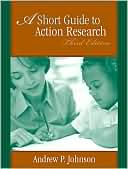

 |

|

The average rating for A Short Guide to Action Research based on 2 reviews is 3 stars.
Review # 1 was written on 2008-12-10 00:00:00 Marc Staley Marc StaleyActually, I've got the first or second edition. Very helpful. Not as much deep theory--much more practical. It helped me get my mind around things. Not the end-all, be-all of action research, but very helpful for beginners like me. |
Review # 2 was written on 2014-09-12 00:00:00 Brent Dunlevy Brent DunlevyReading Basic Principles was a bit like taking in a black-and-white movie. The camera work is steady; the actors are well defined; the plot is simple, if not just a bit familiar… Perhaps some of my familiarity with this script is due to the fact that this rationale for curriculum and instruction is very much the one imposed upon me as a teacher the past four years, right down to the terminology ("sequence," "alignment," etc.). This is not to say that I found Tyler's vision of curriculum and instruction wholly bad. There was, however, an omnipresent sense of control, categorization, and order by teachers and administrators that characterized his view of the learning experience. I got the feeling that Tyler would consider my fifth-grade curriculum perfected if I could render twenty-two behavioral objectives alongside my twenty-seven content aspects - all of which I would evaluate, of course, with assessments, checklists, and questionnaires. Throughout Basic Principles, the watchwords of efficiency and effectiveness lurk behind much of Tyler's rationale. In Tyler's vision of curriculum, learning is something to be made tangible, so that it can be chunked, divided up, and inserted into empty heads on an assembly-line and that the results can be analyzed and conclusions drawn. Certainly, Tyler's rationales were important in their historical context as they helped close the door on rote memorization and provided a useful approach to organizing and unify a school's curriculum and instructional methodology. That the model has endured nearly intact, some sixty years after its being written, is less an indictment of Tyler than it is of policymakers' and school administrators' inability to recognize the potential (and necessity) for other possibilities; in other words, to see the world in color. |
CAN'T FIND WHAT YOU'RE LOOKING FOR? CLICK HERE!!!